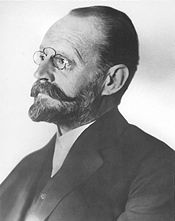- Mischmetal
-
Mischmetal (from German: Mischmetall - "mixed metal") is an alloy of rare earth elements in various naturally occurring proportions. It is also called cerium mischmetal, rare earth mischmetal or misch metal. A typical composition includes approximately 50% cerium and 25% lanthanum, with small amounts of neodymium and praseodymium. Its most common use is in the "flint" ignition device of many lighters and torches, although an alloy of only rare-earth elements would be too soft to give good sparks. For this purpose, it is blended with iron oxide and magnesium oxide to form a harder material known as ferrocerium.
Contents
History
Carl Auer von Welsbach was not only the discoverer of neodymium and praseodymium, and co-discoverer of lutetium, but was also the inventor of the light-mantle (using thorium), and of the rare earth industry. He built a factory to manufacture his mantles, and had discovered that the necessary thorium was available from monazite sand, which at the time originated from Brazil, but which soon thereafter was also coming from North Carolina and India. But after the 6-10% thorium content had been extracted from the monazite, he had a lot of lanthanides left over, for which there was no commercial use. [The 1% of cerium that was added to the thorium oxide to improve the performance was all that could be found initially to usefully employ any of the remaining lanthanide.] Thus, he began exploration for applications to which the rare earths might be put. Among his first discoveries/inventions to bear practical fruit turned out to be Mischmetal and the lighter flint, both of which continue in use a century later. It has been pointed out that von Welsbach was one of the few scientists who has ever been honored with a statue in a public square. The company he founded is still in the rare earth business, and indeed, still in the lighter flint business.
Preparation
Historically, mischmetal was prepared from monazite, an anhydrous phosphate of the light lanthanides and thorium. The ore was "cracked" by reaction at high temperature either with concentrated sulfuric acid, or with sodium hydroxide. Thorium was removed by taking advantage of its weaker basicity relative to the trivalent lanthanides, the radioactive radium isotope daughter products of thorium were precipitated out using entrainment in barium sulfate, and the remaining lanthanides were converted to the chloride. The resulting "Rare Earth Chloride" (Hexahydrate), sometimes known as "Lanthanide Chloride", was the major commodity chemical of the rare earth industry. By careful heating, preferably with ammonium chloride or in an atmosphere of hydrogen chloride, the hexahydrate could be dehydrated to provide the anhydrous chloride. Electrolysis of the molten anhydrous chloride (admixed with other anhydrous halide to improve the melt behavior) led to the formation of molten Mischmetal, which would then be cast into ingots. Any samarium content of the ore tended not to be reduced to the metal, but accumulated in the molten halide, from which it could later be profitably isolated. Monazite-derived Mischmetal typically was about 48% cerium, 25% lanthanum, 17% neodymium, and 5% praseodymium, with the balance being the other lanthanides. When bastnaesite started being processed for rare earth content in about 1965, it too was converted to a version of rare earth chloride, and on to Mischmetal. This version was higher in lanthanum and lower in neodymium.
Currently (2007), the high demand for neodymium has made it profitable to remove all of the heavier lanthanides and neodymium (and sometimes all of the praseodymium as well) from the natural-abundance lanthanide mixture for separate sale, and to include only La-Ce-Pr or La-Ce in the most economical forms of Mischmetal. The light lanthanides are so similar in their metallurgical properties, that any application for which the original composition would have been suitable, would be equally well served by these truncated mixtures. The traditional "Rare Earth Chloride", as a commodity chemical, was also used to extract the individual rare earths by companies that did not wish to process the ores directly. Mischmetal is typically priced at less than 10 dollars per kilogram, and the underlying rare earth chloride mixtures are typically less than 5 dollars per kilogram (as of 2007).
Use
Mischmetal is used in the preparation of virtually all rare earth elements. This is because such elements are nearly identical in most chemical processes, meaning that ordinary extraction processes do not distinguish them. Highly specialized processes, such as those developed by Carl Auer von Welsbach, exploit subtle differences in solubility to separate mischmetal into its constituent elements, with each step producing only an incremental change in composition. Such processes later informed Marie Curie in her search for new elements.
Notes
- R.J. Callow, "The Industrial Chemistry of the Lanthanons, Yttrium, Thorium and Uranium", Pergamon Press, 1967
- Gupta, C. K.; Krishnamurthy, N. (2005). Extractive metallurgy of rare earths. Boca Raton: CRC Press. ISBN 0-415-33340-7.
- F.H. Spedding and A.H. Daane, editors, "The Rare Earths", John Wiley & Sons, 1961.
External links
Categories:- Rare earth alloys
- Cerium compounds
- Lanthanum compounds
Wikimedia Foundation. 2010.


